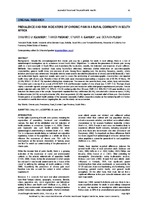| dc.contributor.author | Igumbor, Ehimario U. | |
| dc.contributor.author | Puoane, Thandi | |
| dc.contributor.author | Gansky, Stuart A. | |
| dc.contributor.author | Plesh, Octavia | |
| dc.date.accessioned | 2012-10-01T14:29:03Z | |
| dc.date.available | 2012-10-01T14:29:03Z | |
| dc.date.issued | 2011 | |
| dc.identifier.citation | Igumbor, E.U., Puoane, T., Gansky, S.A. & Plesh, O. (2011). Prevalence and risk indicators of chronic pain in a rural community in South Africa. Journal for Rural and Tropical Public Health, 10: 61-69 | en_US |
| dc.identifier.issn | 1832-2921 | |
| dc.identifier.uri | http://hdl.handle.net/10566/430 | |
| dc.description.abstract | Background: Despite the acknowledgement that chronic pain may be a problem for adults in rural settings, there is a lack of
epidemiological investigations on its occurrence in rural South Africa. Objectives: To estimate the prevalence of chronic pain among
adults in a rural community in South Africa and characterize the localization, severity, risk indicators and responses of pain sufferers.
Methods: Cross-sectional analytical study using face-to-face interviews. Interviews elicited information on socio-demographic
characteristics, general health status and presence of pain. Among those reporting pain, the duration, frequency, severity, activity
limitation and impact was determined. Univariate statistics were used to describe the prevalence of chronic pain while bivariable χ2 tests
and multivariable logistic regression models were used to assess the relationship of socio-demographic characteristics and reported
health status with chronic pain. Results: A total of 394 adults were interviewed representing a response rate of 92.8%. Of these, 169
(42.9%; 95% CI: 37.4%-47.1%) reported suffering from chronic pain. The common sites were the back, knee, ankles, head and shoulders.
The median pain score was 6 on a scale of 0-10 (IQR= 5-8) and the median number of sites of pain was 1 (IQR= 1-2). The type of pain
slightly varied with age with younger adults reporting more back pain and headaches while older people reported more joint pain. Female
gender (adjusted odds-ratio AOR= 2.2, 95% CI: 1.9-2.8) and being older than 50 years (AOR= 3.1, 95% CI:2.7-3.9) were identified as risk
indicators for chronic pain in the sample. Respondents reported that they self-treated (88.3%); consulted with a doctor or nurse (74.3%);
traditional-healer (24.5%) and spiritual-healer (4%). Most respondents (63.4%) reported only transient relief of their pain. Conclusions:
Chronic pain is an important health problem in the surveyed community. Further comparative studies on the relationship with risk factors
are needed meanwhile interventions targeting females and the elderly are recommended. | en_US |
| dc.language.iso | en | en_US |
| dc.publisher | James Cook University | en_US |
| dc.rights | © 2011 Igumbor et al; licensee James Cook University. This is an Open Access article distributed under the terms of the Creative Commons License, which permits unrestricted use, distribution, and reproduction in any medium, provided the original work is properly cited. | |
| dc.subject | Chronic pain | en_US |
| dc.subject | Prevalence | en_US |
| dc.subject | Rural | en_US |
| dc.subject | Eastern Cape Province | en_US |
| dc.subject | South Africa | en_US |
| dc.title | Prevalence and risk indicators of chronic pain in a rural community in South Africa | en_US |
| dc.type | Article | en_US |
| dc.privacy.showsubmitter | false | |
| dc.status.ispeerreviewed | true | |

